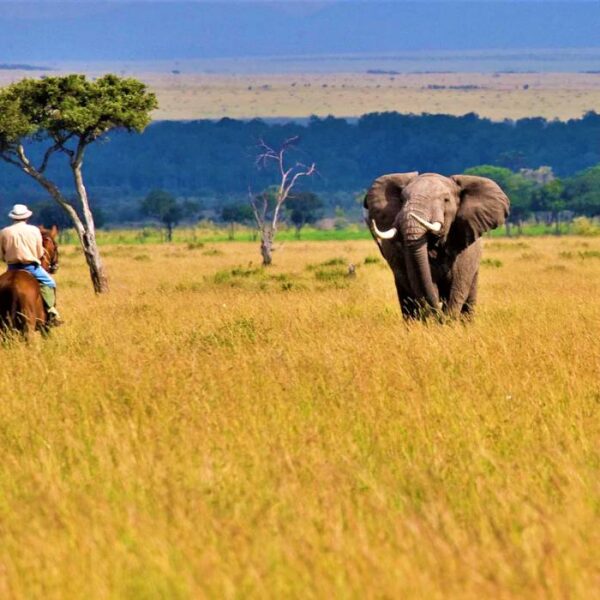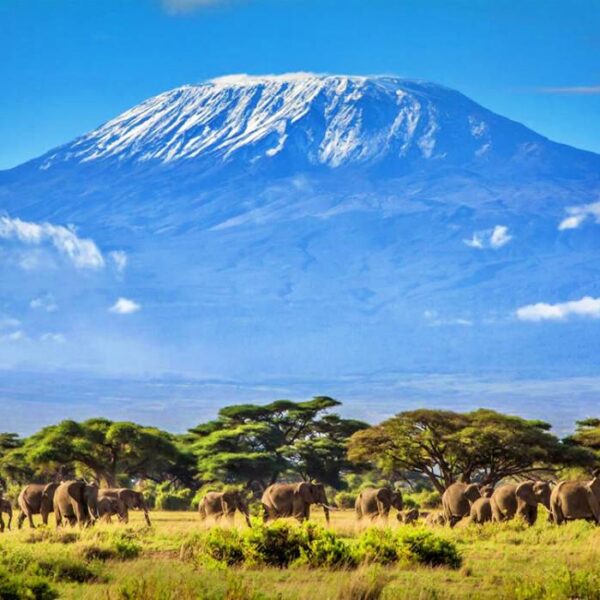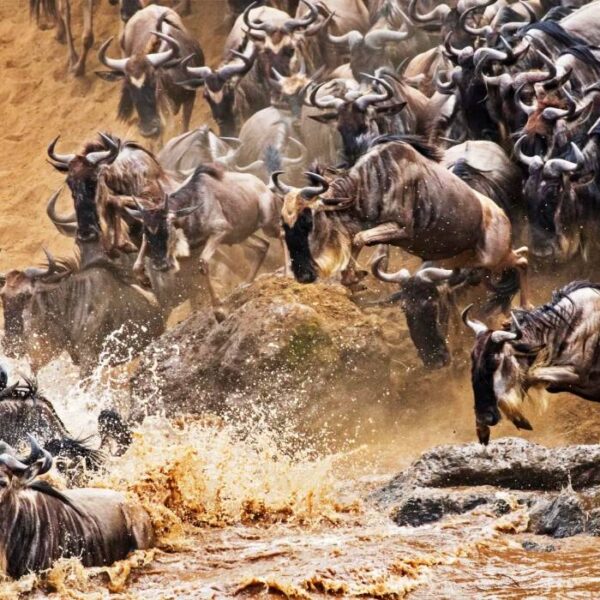The Maasai Mara National Reserve in Kenya is one of the most celebrated and sought-after safari destinations in the world, and for a good reason. This iconic reserve, with its vast savannahs, rich wildlife, and spectacular landscapes, offers an unparalleled safari experience. But what truly sets the Maasai Mara apart is the awe-inspiring Great Migration, one of nature’s most extraordinary spectacles. Here’s your ultimate guide to discovering the magic of the Great Migration in the Maasai Mara.
What is the Great Migration?
The Great Migration is an annual, circular journey of over 1.5 million wildebeest, accompanied by hundreds of thousands of zebras and gazelles, across the Serengeti-Mara ecosystem. This epic migration covers approximately 1,800 miles, starting in Tanzania’s Serengeti National Park and moving north into Kenya’s Maasai Mara National Reserve before returning south again.
The Journey of the Great Migration
The Great Migration is driven by the search for fresh grazing and water, dictated by the seasonal rains. Here’s a breakdown of the migration’s journey throughout the year:
January to March: Calving Season in the Southern Serengeti
The migration starts in the southern Serengeti, where the wildebeest give birth to around 500,000 calves within a few weeks. The lush plains provide ample nourishment for the newborns, and the spectacle of thousands of calves taking their first steps is a sight to behold.
April to June: The Long Trek North
As the rains begin to wane, the herds start moving northwest toward the Grumeti River, where they face their first major obstacle: crossing the crocodile-infested waters. The journey is fraught with danger, but the promise of greener pastures drives them onward.
July to October: Crossing into the Maasai Mara
This is the most anticipated phase of the migration. The herds reach the Mara River, the gateway to the Maasai Mara. The river crossings are dramatic and often perilous, with crocodiles lying in wait and predators like lions, leopards, and hyenas taking advantage of the chaos. Once across, the herds spread out across the Mara’s lush plains, offering exceptional game-viewing opportunities.
November to December: Returning to the Serengeti
With the onset of the short rains, the herds begin their journey back to the southern Serengeti, completing the cycle. The migration is a continuous process, and the herds are always on the move, driven by the changing seasons and the search for sustenance.
Best Time to Witness the Great Migration in the Maasai Mara
The best time to witness the Great Migration in the Maasai Mara is from July to October. This period coincides with the river crossings, which are the most dramatic and action-packed events of the migration. However, the exact timing can vary each year depending on the rains, so it’s essential to stay flexible and consult with local experts when planning your trip.
Top Spots for Viewing the Great Migration
The Maasai Mara offers several prime locations for witnessing the Great Migration:
Mara River
The Mara River is the focal point of the migration, where the herds make their dramatic crossings. Several viewpoints along the riverbanks offer excellent vantage points for observing the action. The crossings can occur at any time of day, so patience is key.
Musiara Marsh
Located near the Mara River, the Musiara Marsh is a hotspot for predators, especially lions. The marsh’s lush vegetation attracts the herds, providing ample hunting opportunities for the resident big cats.
Talek and Sand Rivers
These rivers, though smaller than the Mara River, also see significant migration activity. The surrounding areas are less crowded, offering a more intimate safari experience.
Tips for an Unforgettable Great Migration Safari
To make the most of your Great Migration safari, consider the following tips:
Choose the Right Accommodation
Staying in strategically located lodges and camps can make a significant difference in your migration experience. Here are a few recommendations:
- Luxury Lodges: Angama Mara, Governors’ Camp, and Mara Explorer Camp offer top-notch amenities, exceptional service, and prime locations near the migration hotspots.
- Mid-Range Lodges: Entim Camp, Mara Intrepids, and Fig Tree Camp provide comfortable accommodations and excellent game-viewing opportunities.
- Budget Camps: Mara Springs Safari Camp, Aruba Mara Camp, and Enchoro Wildlife Camp offer more affordable options without compromising on the safari experience.
Hire an Experienced Guide
A knowledgeable guide can enhance your safari experience with their expertise in tracking the herds and understanding animal behavior. They can also navigate the reserve’s terrain and find the best spots for viewing the migration.
Be Patient and Flexible
The migration is a natural event, and sightings can be unpredictable. Patience and flexibility are essential. Spend several days in the reserve to increase your chances of witnessing the river crossings and other migration highlights.
Pack Wisely
Bring comfortable clothing suitable for the varying temperatures, sturdy footwear, binoculars, a good camera with a zoom lens, and essentials like sunscreen, insect repellent, and a hat. Layered clothing is ideal for the cool mornings and evenings and warm afternoons.
Cultural Experiences in the Maasai Mara
Enhance your safari adventure by engaging with the local Maasai communities. The Maasai people have lived in harmony with the wildlife for centuries, and their rich culture and traditions add a unique dimension to your safari experience.
Maasai Village Visits
A visit to a Maasai village offers insights into their traditional way of life, including their cattle herding practices, intricate beadwork, and vibrant dances. Many lodges and camps offer organized tours to nearby villages, providing an opportunity to learn about the Maasai’s customs and way of life.
Community Conservation Projects
Many lodges and camps in the Maasai Mara work closely with local communities on conservation projects. Participating in these initiatives provides a deeper understanding of the challenges and successes in wildlife conservation and offers a chance to contribute to sustainable tourism efforts.
Wildlife Beyond the Great Migration
While the Great Migration is the main attraction, the Maasai Mara is home to a rich diversity of wildlife that can be observed year-round. Here are a few highlights:
Big Cats
The Maasai Mara is renowned for its high concentration of big cats, including lions, leopards, and cheetahs. The Musiara Marsh and the areas around the Mara and Talek Rivers are prime spots for big cat sightings.
Elephants and Buffalo
Large herds of elephants and buffalo roam the plains of the Maasai Mara. These magnificent creatures can often be seen near water sources and open grasslands.
Birds
The Maasai Mara is a bird watcher’s paradise, with over 470 bird species recorded. From raptors like the African fish eagle and martial eagle to vibrant species like the lilac-breasted roller and the saddle-billed stork, the birdlife is diverse and abundant.
Hippos and Crocodiles
The Mara River is home to large populations of hippos and crocodiles. These river giants can often be seen basking on the riverbanks or submerged in the water.
Planning Your Great Migration Safari
Planning a Great Migration safari requires careful consideration to ensure a smooth and enjoyable experience. Here are a few key points to keep in mind:
Choosing a Safari Operator
Select a reputable safari operator with experienced guides and good reviews. Look for operators who are committed to sustainable tourism and community involvement. They should offer flexible itineraries to maximize your chances of witnessing the migration.
Health and Safety
Ensure you have the necessary vaccinations and travel insurance. Kenya is a malaria-endemic country, so taking prophylactic medication and using insect repellent is essential. Consult with your healthcare provider for personalized advice.
Travel Logistics
Nairobi, Kenya’s capital, serves as the main gateway to the Maasai Mara. From Nairobi, you can take a domestic flight to one of the airstrips in the Mara or opt for a scenic road transfer. Domestic flights are quicker and more convenient, while road transfers offer the chance to see more of Kenya’s landscapes and local communities.
Conclusion
Witnessing the Great Migration in the Maasai Mara is a once-in-a-lifetime experience that leaves a lasting impression. The sheer scale of the migration, the dramatic river crossings, and the rich wildlife make it one of the most spectacular natural events on Earth. By planning your safari carefully, choosing the right accommodation and guides, and immersing yourself in the local culture, you can create unforgettable memories of this magical phenomenon.
Whether you’re a seasoned safari-goer or a first-time visitor, the Great Migration in the Maasai Mara promises an adventure like no other. So pack your bags, charge your camera, and get ready to discover the magic of the Great Migration in the heart of Kenya’s Maasai Mara National Reserve.



